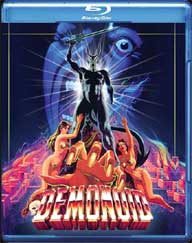 DEMONOID
(1981) Blu-ray/DVD combo
DEMONOID
(1981) Blu-ray/DVD comboDirector: Alfredo Zacharias
Vinegar Syndrome
 DEMONOID
(1981) Blu-ray/DVD combo
DEMONOID
(1981) Blu-ray/DVD combo"Up from the depths of hell comes" DEMONOID (it had to eventually) on a very revealing Blu-ray/DVD combo from Vinegar Syndrome.

Jennifer Baines (Samantha Eggar, CURTAINS) travels to Guanajuato, Mexico to join her husband Mark (Roy Cameron Jenson, THE CAR) who has sunk all of his money in the ancient La Quemada silver mine that has not given up its treasure after three hundred years of digging. Jennifer scoffs foreman Pepe's (José Chávez, THE WILD BUNCH) warning that a woman entering the mine is bad luck, but the workers become afraid once she accidentally unearths the mummified corpse of a silver prospector missing his left hand (which Pepe reveals is regarded by elders as "the devil's hand"). She and Mark discover at the lowest level a temple with an altar dedicated to a devil statue also missing its left hand. Mark removes a silver casket shaped like a life-sized hand from the altar, but his act of desecration does little to assuage the frightened workers and they refuse to go back to work. While drowning his sorrows back at the hotel with Jennifer, Mark opens the casket and finds only ashes but they soon coalesce into a severed hand that attacks him before disappearing. The next morning, Jennifer is shocked when Mark forces the workers into the mine and blows it up before driving off. She tracks him down to Las Vegas via a newspaper story about his inexplicable good luck at the tables, but she loses him when crook Frankie (Ted White, THE HIDDEN) and his moll Angela (Russ Meyer favorite Haji) try to extract the source of Mark's good luck by torture in a shack that goes up in flames. Mark's body is misidentified as that of a prospector and shipped to California for burial by relatives. Jennifer follows and appeals to Father Cunningham (Stuart Whitman, SHATTER), the priest who buried him, for help in destroying the hand that possessed her husband and that she believes has also marked her as its next owner. Cunningham is dealing with his own faith issues and is uncertain whether he believes in good and evil much less an ancient killer hand, but he is soon on the trail as the evil moves from host to host endeavoring to give Jennifer "a hand" while leaving a trail of horrible mutilated bodies in its wake.
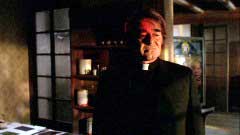 A
strongly cast and well-mounted production, DEMONOID's absurd plot (well, it's
better than THE CRAWLING HAND) is kept engaging through its "everything
but the kitchen sink" plotting, satisfying gore (courtesy of HELL NIGHT's
Ken Horn), and some genuine nastiness. "Globe hopping" from scenic
Mexico (while not getting quite as much mileage out of the Guanajuato mummies
as Werner Herzog in NOSFERATO) to glitzy Las Vegas to meh Inglewood, the film
tosses in explosions, walking corpses, car chases, and several different methods
of hand-lopping before a suspenseful stalking sequence when even a church cannot
offer sanctuary against the devil. Although the characters are not as compelling
as the script or the actors would like, Eggar and Whitman are engaging as she
tires of trying to convince him and then tries to goad him to admit that he
has not completely lost his faith and the possibility of evil as a supernatural
force. The production design is the work of Javier Torres Torija, a veteran
of many a Mexican horror film at Churubusco studios while Robert Burns (THE
TEXAS CHAINSAW MASSACRE) is credited with "special effects art direction"
and may have been responsible for the demon statue that appears in flashes whenever
the hand attacks which is more stylized than the one seen in the temple. The
cinematography of Álex Phillips Jr. (BRING ME THE HEAD OF ALFREDO GARCIA)
is occasionally rough, suggestive of a rushed schedule, but generally of a high
standard with some atmospheric lighting effects that make effective use of moving
shadows (including the shadow of Eggar's own offscreen hand against the mine
wall seeming to creep up on her as she fiddles with her flashlight). The cast
includes CHiPs' Lew Saunders as a cop and THE DEVIL'S RAIN's Erika Carlsson
as a nurse who both run afoul of the hand.
A
strongly cast and well-mounted production, DEMONOID's absurd plot (well, it's
better than THE CRAWLING HAND) is kept engaging through its "everything
but the kitchen sink" plotting, satisfying gore (courtesy of HELL NIGHT's
Ken Horn), and some genuine nastiness. "Globe hopping" from scenic
Mexico (while not getting quite as much mileage out of the Guanajuato mummies
as Werner Herzog in NOSFERATO) to glitzy Las Vegas to meh Inglewood, the film
tosses in explosions, walking corpses, car chases, and several different methods
of hand-lopping before a suspenseful stalking sequence when even a church cannot
offer sanctuary against the devil. Although the characters are not as compelling
as the script or the actors would like, Eggar and Whitman are engaging as she
tires of trying to convince him and then tries to goad him to admit that he
has not completely lost his faith and the possibility of evil as a supernatural
force. The production design is the work of Javier Torres Torija, a veteran
of many a Mexican horror film at Churubusco studios while Robert Burns (THE
TEXAS CHAINSAW MASSACRE) is credited with "special effects art direction"
and may have been responsible for the demon statue that appears in flashes whenever
the hand attacks which is more stylized than the one seen in the temple. The
cinematography of Álex Phillips Jr. (BRING ME THE HEAD OF ALFREDO GARCIA)
is occasionally rough, suggestive of a rushed schedule, but generally of a high
standard with some atmospheric lighting effects that make effective use of moving
shadows (including the shadow of Eggar's own offscreen hand against the mine
wall seeming to creep up on her as she fiddles with her flashlight). The cast
includes CHiPs' Lew Saunders as a cop and THE DEVIL'S RAIN's Erika Carlsson
as a nurse who both run afoul of the hand.
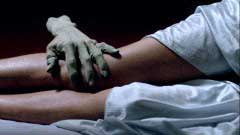
The first of two releases by American Panorama – a company co-founded by Zacharias and Lawrence Woolner – DEMONOID was released to VHS stateside in a darkish transfer by Media Home Entertainment. Before Vinegar Syndrome's current Blu-ray/DVD combo, the film was only available on the digital format on a Spanish-language Mexican-American DVD under the title MACABRA. Vinegar Syndrome's release features two cuts of the film under the titles DEMONOID and MACABRA, and the latter turns out not to be a softer Spanish version but reveals that the film exists in two versions to cater to different markets. Although Vinegar Syndrome's back cover refers to the international version (90:14) as radically re-edited, it actually appears as if this was the version that was prepared first and the DEMONID version (79:56) – though it may be considered the official cut and the one of preference to the director – trimmed down and augmented with new footage, alternate gorier takes, some optical slow-motion for emphasis, pared down for pacing (as wells as losing two ropier bits of acting from Eggar), and a less-effective but more overtly horrific score that includes some synth music and what seems like a lot of disparate library cues (presumably the MACABRA score was composed by credited Richard Gillis since he also did THE BEES for Zacharias).
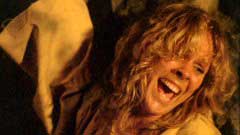 While
the American version begins with a period flashback featuring a busty blond,
MACABRA begins with the credits and a "majestic" (as the English SDH
subtitles refer to it) music that recurs throughout the international versions
in moments where good temporarily overcomes evil. The more sinister bits are
scored with choral cues that are more suggestive of EXORCIST II: THE HERETIC
than THE OMEN. Bits of scenic padding and some redundant dialogue in the longer
version is lost (the editing on DEMONOID feels blunt during these bits once
you have seen the longer version), and all of the head-crushing deaths are more
graphic and make use of prop heads and prosthetic appliances rather than the
suggestive sound effects of the longer cut (which still does feature a goodly
amount of gore whenever hands are severed). The shorter cut also adds flash
cuts to the silhouetted form of the demon whenever characters open the casket
or come under possession as well as some optical flashes when possessed characters
try to free themselves. The more ambiguous ending of the international version
(which makes thematic sense) is extended with an Eggar double and some grisly
but unconvincing effects. It is difficult to say which version is superior as
the inserts and flash cuts on DEMONOID are effective, but the pacing and scoring
is better on MACABRA.
While
the American version begins with a period flashback featuring a busty blond,
MACABRA begins with the credits and a "majestic" (as the English SDH
subtitles refer to it) music that recurs throughout the international versions
in moments where good temporarily overcomes evil. The more sinister bits are
scored with choral cues that are more suggestive of EXORCIST II: THE HERETIC
than THE OMEN. Bits of scenic padding and some redundant dialogue in the longer
version is lost (the editing on DEMONOID feels blunt during these bits once
you have seen the longer version), and all of the head-crushing deaths are more
graphic and make use of prop heads and prosthetic appliances rather than the
suggestive sound effects of the longer cut (which still does feature a goodly
amount of gore whenever hands are severed). The shorter cut also adds flash
cuts to the silhouetted form of the demon whenever characters open the casket
or come under possession as well as some optical flashes when possessed characters
try to free themselves. The more ambiguous ending of the international version
(which makes thematic sense) is extended with an Eggar double and some grisly
but unconvincing effects. It is difficult to say which version is superior as
the inserts and flash cuts on DEMONOID are effective, but the pacing and scoring
is better on MACABRA.

Mastered from 2K scans of the original 35mm negatives, the 1080p24 MPEG-4 AVC 1.78:1 widescreen encodes of both DEMONOID and MACABRA look similarly strong with heavy grain cropping up in some underexposed night shots (particularly in Mexico) and opticals including the opening titles (which seem to have been darkened on DEMONOID to suggest night). The inconsistent detail between scenes and shots seems to be a matter of the cinematography rather than the condition of the elements. The DTS-HD Master Audio 1.0 tracks on both versions are of similar quality with effective rendition of the music and sound effects. MACABRA also features an additional Dolby Digital 1.0 French dub of lesser quality. The optional English SDH subtitles for the theatrical version refer to the mine as La Quemada while the subtitles for the international version refer to it as Lacemada.
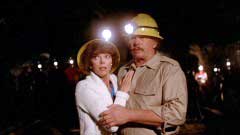 In
"The Devil's Hand" (14:35), director Zacharias describes the inspiration
for the film stemming from a conversation with a psychiatrist friend about split
personalities, mythology about the "sinister" left hand, and specifically
a myth about the hand of the devil. He speaks highly of Eggar, Whitman, and
Jensen (who had some issues with the script due to his religious beliefs), and
of cinematographer Phillips who preferred perfect static compositions while
Zacharias wanted the camera to be constantly on the move. He describes the film
as the first and last he distributed himself, citing the competitive distribution
market at the time and his preference for writing, producing, and directing
(American Panorama's only other release was the RAW FORCE, also available from
Vinegar Syndrome). The DEMONOID theatrical trailer (1:19) is flashy, spoilersome,
and fast-paced while the one for MACABRA (3:26) is more informative about the
story but lacks excitement. A TV Spot for MACABRA (0:11) with an R-rating is
also included, so that version may have been marketed in some American markets.
The artwork gallery (1:29) features the American poster and MACABRA artwork
including some German lobby cards. The front cover sports the American DEMONOID
artwork that looks like a heavy metal cover while the MACABRA art on the reverse
is cheesier in its rendition of a Guanajuato mummy as a zombie.
(Eric
Cotenas)
In
"The Devil's Hand" (14:35), director Zacharias describes the inspiration
for the film stemming from a conversation with a psychiatrist friend about split
personalities, mythology about the "sinister" left hand, and specifically
a myth about the hand of the devil. He speaks highly of Eggar, Whitman, and
Jensen (who had some issues with the script due to his religious beliefs), and
of cinematographer Phillips who preferred perfect static compositions while
Zacharias wanted the camera to be constantly on the move. He describes the film
as the first and last he distributed himself, citing the competitive distribution
market at the time and his preference for writing, producing, and directing
(American Panorama's only other release was the RAW FORCE, also available from
Vinegar Syndrome). The DEMONOID theatrical trailer (1:19) is flashy, spoilersome,
and fast-paced while the one for MACABRA (3:26) is more informative about the
story but lacks excitement. A TV Spot for MACABRA (0:11) with an R-rating is
also included, so that version may have been marketed in some American markets.
The artwork gallery (1:29) features the American poster and MACABRA artwork
including some German lobby cards. The front cover sports the American DEMONOID
artwork that looks like a heavy metal cover while the MACABRA art on the reverse
is cheesier in its rendition of a Guanajuato mummy as a zombie.
(Eric
Cotenas)